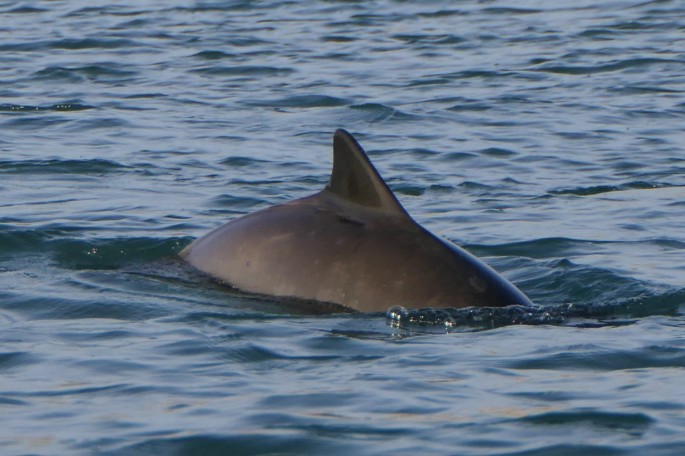
You might think it’s no big deal to photograph the same Harbour Porpoise in more or less the same place three times in a month. Unlike dolphins which are highly mobile and could be dozens of miles away the next day, porpoises seem to be regular at certain sites around southwest England, particular headlands, and nowhere I have paddled holds a more reliable pod of porpoises than Berry Head.
It is certainly the best spot to see a porpoise from a kayak because of its proximity to an excellent launch spot at Brixham and its relatively sheltered location which results in a smooth sea surface (essential for porpoise-spotting) more often than headlands further west. Further west generally means a more disturbed sea state with more wind, swell, and tidal flow.
Berry Head also has a very well-defined tideline along which the porpoises, if they are around, love to forage.
video:
So why am I so excited about Notchy?
For a start Notchy is the first identifiable (because of the notch at the base of his/her dorsal fin) cetacean I have seen on more than one occasion. Apart from Horace the Humpback whale that is (which was rather more easy to spot).
Secondly it is a window into the population dynamics of Harbour Porpoises. Is the same group here all the time? Or is there a hard core with a mobile population that comes and goes? Is there a seasonal pattern or is availability of fish more of an influence?
The possible answers to all of these questions are tremendously blurred by the difficulty of observing porpoises in anything apart from calm conditions. As soon as there are any breaking whitecaps the chances of seeing a fin reduce considerably. This is certainly the case from kayak and I would only consider venturing offshore in absolutely calm conditions. It is maybe not quite so critical if watching from a telescope from Berry Head.
The overall impression I get from observing porpoises from my kayak all round SW England is that there is a peak of numbers in August which falls away till early in the year, then very few about in April to June before numbers rapidly build. This is skewed by the sea conditions which are smoother in summer which encourage me to go out to where the porpoises hang out more, but it is interesting that I usually see numbers into double figures (max 24 this year) in August and September, but only ones and twos in May.
I think that availability of their favourite food has a lot to do with this apparent seasonality, with the appearance of mackerel accounting for the late summer surge, with herring and pilchard appearing in early winter, and a noticeable gap in these tasty fish in the Spring.
Socialisation might have something to do with it, with the main ‘rutting’ season for porpoises known to be in late summer, maybe contributing to increased group size (like a sort of porpoise Magaluf).
video:
My son Henry had to good fortune to snap this pic of an ultra-rare white porpoise off the North coast of Cornwall, and to the best of my knowledge it hasn’t been seen since, but it would be quite easy for a five foot long porpoise to get lost in the swells of the north coast as there aren’t many observers or boats about up there (and I’m not very well ‘connected’). But this would suggest that porpoises do travel.

Coming back to the Berry Head porpoise pod, I would guess that there is a nucleus which is added to, and thins out, according to seasonality of their baitfish.
If you like hunting along a tideline you will not find one more pronounced than Berry Head. It must be like being permanently camped in the carpark of MacDonalds, if you are partial to a Big Mac.
So back to ‘Notchy’. here he/she is on three dates in December. Characteristic notch at the back of the fin clearly visible in each pic.



Photographing porpoises is incredibly difficult, and doubly so from a kayak. After you see them surface for the first time you must predict where they will next appear. This is easy for a dolphin because they usually progress in a straight line, but porpoises will zigzag about all over the place underwater and could pop up anywhere. Add in the small size of the fin and the movement of the kayak, and that the porpoise could surface directly behind you or disappear completely, and it can get a tad frustrating.
I don’t have any idea of whether I have got any photos in focus, let alone any distinguishing features, until I get back to the stability of the shore.
So to picture the same one three times is a bit of a surprise.
Porpoises hardly ever breach but during my last visit there was one which was extremely pumped up and leapt clear of the water on a couple of occasions. Unfortunately I was a split second too late with the shutter.

I also observed one resting at the surface, a behaviour I have only rarely seen before, and only when the sea is completely smooth (although I suppose I wouldn’t see it if was choppy anyway). Video:
Far out to sea I caught a split second glimpse of a jumping beast so paddled out to investigate, and was pleased to see a couple of Common Dolphins cruising along at a speed which I could only match by paddling flat out.

With a bit of luck 2019 will be equally as enthralling, and maybe Notchy will still be around.














